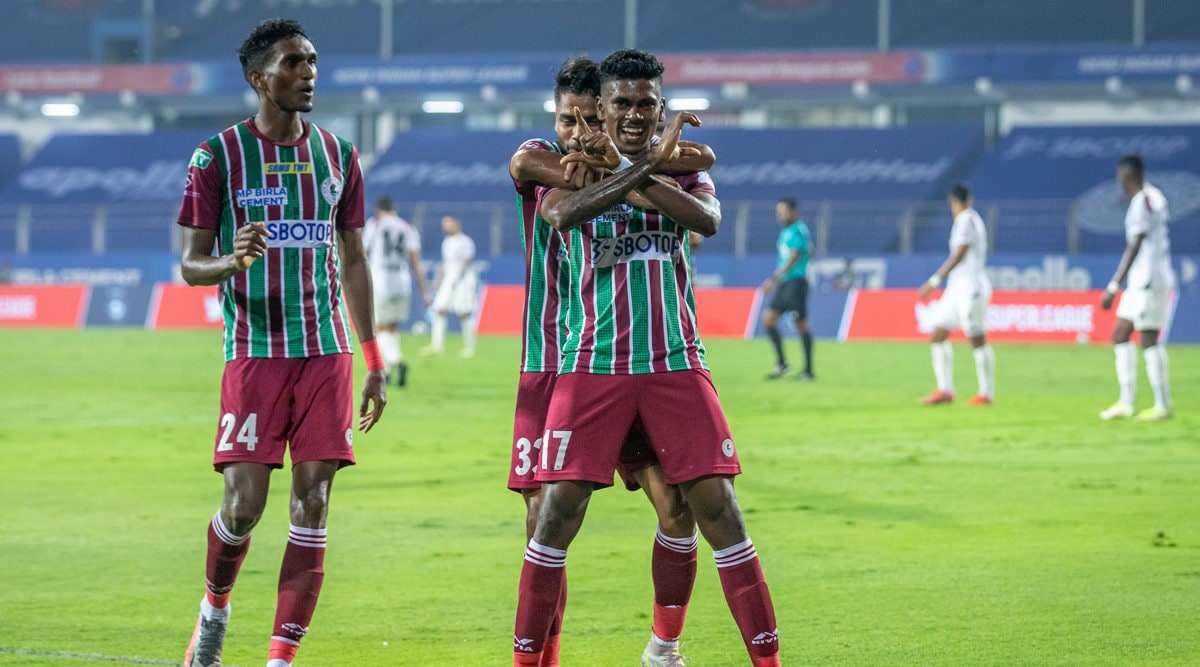 With eight goals so far this season, ATK Mohun Bagan's Liston Colaco is the highest goal scorer among Indian players this season. ISL
With eight goals so far this season, ATK Mohun Bagan's Liston Colaco is the highest goal scorer among Indian players this season. ISL Fifty-three Indian players have found their names on the score sheet in this season of the Indian Super League (ISL). Fifty-eight have provided assists. On both fronts, the number is higher than in the previous seasons.
As the group stage of the ISL enters its last stretch, and the final match will be played next Monday, these two stats stand out. The reason for an increased attacking contribution by Indian players is straightforward – more playing opportunities.
This is the first season when only four foreigners are allowed in the playing 11 at any given point, fewer than the previous editions. This meant Indians, who have previously starved for game time, got more playing opportunities, especially in advanced positions where they could directly influence the play. It’s been a feature right from the first matchday, when Kerala Blasters’ Sahal Abdul Samad and ATK Mohun Bagan’s Liston Colaco scored beautiful goals to set the ball rolling for other Indians.
Poster boy of Indian football – Liston Colaco, 8 goals, 3 Assists. What an unbelievable season pic.twitter.com/OtUD2gF6lh
— Karthik Raj (@kartcric) February 27, 2022
It’s a trend national team coach Igor Stimac would be pleased with as he prepares for the international friendlies next month as well as Asian Cup qualifiers in June. At the same time, a recent decision by the Asian Football Confederation (AFC) will concern Stimac.
Last week, the continental body announced that the number of foreign players in the 11 has been increased from the existing four to six (including one mandatory from Asia) for club competitions. This means more than half of the players on the pitch could be foreigners, leading to a sharp reduction in game-time for homegrown players.
For India, the rule change comes at an inopportune time. It took seven seasons for the ISL to fall in line with the previous existing AFC rule of having a maximum of four imports in the 11. Ironically, in the season they chose to implement it, the AFC changed its criteria.
The rule isn’t binding on the leagues. If it wants, the All India Football Federation (AIFF) can continue to keep the four-foreigner cap on teams, which has been enforced this season and clearly helped Indian players.
The AIFF has hinted at maintaining the status quo, something that Stimac, too, has wished. But it remains to be seen if the league and the clubs, who will compete with Asia’s finest in the Champions League, agree, given the impact foreigners have on the results as well as the quality.
Asian Champions League conundrum
The cap on foreigners isn’t the only decision the AIFF will have to take.
Along with the foreign player rule, the AFC also changed its calendar for club competitions – from Autumn-Spring to Spring-Autumn – to synchronise it with the global transfer window. The new Asian Champions League edition, in which Mumbai City will participate, will begin in April and end in February 2023. The next one, however, will begin only in September 2023.
Consequently, the AIFF is confronted with a bizarre problem. The winners of the group stage of the ongoing ISL season have been assured of a Champions League slot. However, by the time the 2023-24 edition arrives, the 2022-23 season of the ISL will have concluded as well. That means India will have two candidates for one spot unless the same team wins both seasons.
At present, Hyderabad FC are on the top of the table, and in pole position to win the ACL berth. As things stand, if they do end up qualifying, Hyderabad will have to wait for 16 months before they get to play in the Champions League. And in that case, what happens to the winners of next season is a question that will need an answer.
Home-and-away format to return
While some crucial points remain unanswered for the next season, one thing that looks certain is that after two seasons in a bubble, the country’s top-two tiers, the ISL and the I-League are set to return to the home-and-away format.
Since the pandemic began, the ISL has been held in Goa while Kolkata has hosted the I-League, which will resume on March 3 after the season was suspended in December following a Covid outbreak among teams.
The ISL organisers have already written to the clubs, asking them to confirm the availability of venues in their base cities. Almost all teams look certain to return to their usual venues for the 2022-23 season except Bengaluru FC, whose return to Kanteerva has come under a cloud after Karnataka’s sports minister KC Narayana Gowda said the stadium will no longer be used for football.
On Sunday, I-League chief executive Sunando Dhar said it will be ‘best for everyone’ to return to home-and-away format ‘as soon as possible’. “The plans that we have for the 2022-23 season is to have home-and-away,” Dhar said, adding that they are also exploring the possibility of allowing fans into the stadium this season.
- The Indian Express website has been rated GREEN for its credibility and trustworthiness by Newsguard, a global service that rates news sources for their journalistic standards.

